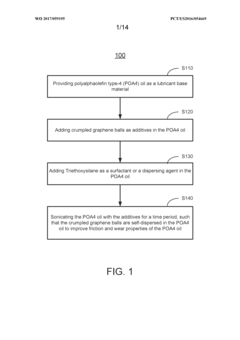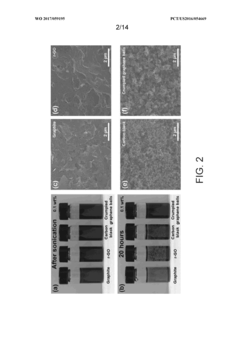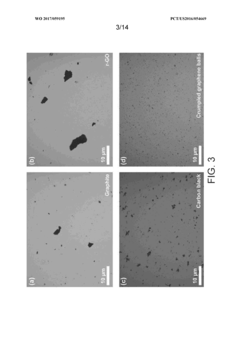How to Reduce Friction with Graphene Oxide-Based Lubricants?
Graphene Oxide Lubricants: Background and Objectives
Graphene oxide (GO) has emerged as a promising material in the field of lubrication due to its unique properties and potential to significantly reduce friction in various mechanical systems. The development of GO-based lubricants represents a convergence of nanotechnology and tribology, aiming to address the persistent challenges of energy loss and wear in moving parts.
The evolution of lubricant technology has been driven by the need for improved efficiency and durability in mechanical systems. Traditional lubricants, while effective, have limitations in extreme conditions and often contribute to environmental concerns. The advent of nanomaterials, particularly graphene and its derivatives, has opened new avenues for lubricant formulation with enhanced performance characteristics.
Graphene oxide, a functionalized form of graphene, possesses exceptional mechanical strength, thermal conductivity, and chemical stability. These properties make it an ideal candidate for incorporation into lubricants. The primary objective in developing GO-based lubricants is to exploit the material's two-dimensional structure and surface chemistry to create a stable and effective lubricating film between moving surfaces.
The technical goals for GO lubricants include achieving ultra-low friction coefficients, extending the operational life of mechanical components, and maintaining performance under extreme pressure and temperature conditions. Researchers aim to optimize the dispersion of GO in various base oils and develop methods to enhance its interaction with metal surfaces for improved adherence and lubrication.
Another critical objective is to understand and control the tribochemical reactions that occur at the GO-metal interface during lubrication. These reactions can lead to the formation of protective tribofilms, further reducing friction and wear. The ultimate aim is to create smart lubricants that can adapt to changing conditions and self-heal under stress.
Environmental considerations also play a significant role in the development of GO lubricants. There is a growing emphasis on creating eco-friendly lubricant formulations that reduce the environmental impact of lubricant disposal and leakage. GO's potential biodegradability and low toxicity align well with these sustainability goals.
As research progresses, the focus is shifting towards scalable production methods for GO lubricants, ensuring consistent quality and performance. The integration of GO into existing lubricant systems and the development of new, specialized formulations for specific industrial applications are key areas of investigation. The overarching goal is to transition GO lubricants from laboratory success to widespread industrial adoption, revolutionizing friction reduction across various sectors.
Market Analysis for Low-Friction Lubricants
The market for low-friction lubricants has been experiencing significant growth in recent years, driven by the increasing demand for energy-efficient and high-performance solutions across various industries. The global lubricants market is expected to reach a substantial value by 2025, with low-friction lubricants playing a crucial role in this expansion.
The automotive sector remains a key driver for low-friction lubricants, as manufacturers strive to meet stringent fuel efficiency standards and reduce emissions. The adoption of advanced engine technologies and the shift towards electric vehicles have further amplified the need for specialized lubricants that can minimize friction and wear.
Industrial applications represent another major market segment for low-friction lubricants. Manufacturing, energy production, and heavy machinery industries are increasingly seeking ways to improve operational efficiency and reduce maintenance costs. Low-friction lubricants offer a promising solution by extending equipment lifespan and reducing energy consumption.
The aerospace industry is emerging as a high-potential market for advanced lubricants, particularly those based on novel materials like graphene oxide. The extreme operating conditions in aerospace applications demand lubricants with exceptional performance characteristics, creating opportunities for innovative solutions.
Geographically, North America and Europe currently lead the market for low-friction lubricants, owing to their advanced industrial base and stringent environmental regulations. However, the Asia-Pacific region is expected to witness the fastest growth, driven by rapid industrialization, increasing automotive production, and growing awareness of energy efficiency.
The market landscape is characterized by intense competition among established lubricant manufacturers and new entrants specializing in advanced materials. Key players are investing heavily in research and development to create novel formulations that can offer superior friction reduction properties.
Consumer trends indicate a growing preference for environmentally friendly and sustainable lubricant solutions. This shift is prompting manufacturers to develop bio-based and biodegradable low-friction lubricants, opening up new market opportunities and potential price premiums for eco-friendly products.
The integration of nanotechnology, particularly the use of graphene oxide, in lubricant formulations represents a significant technological trend. These advanced materials offer the potential for unprecedented levels of friction reduction and wear protection, potentially revolutionizing the lubricants market.
Current Challenges in Graphene Oxide-Based Lubrication
Despite the promising potential of graphene oxide-based lubricants in reducing friction, several significant challenges persist in their development and application. One of the primary obstacles is the stability of graphene oxide (GO) dispersions in various lubricant base oils. GO tends to agglomerate over time, leading to reduced effectiveness and potential damage to lubricated surfaces. This instability is particularly pronounced in non-polar base oils, which are commonly used in industrial applications.
Another critical challenge is the optimization of GO concentration in lubricant formulations. While higher concentrations of GO can potentially offer better friction reduction, they may also lead to increased viscosity, negatively impacting the overall performance of the lubricant. Striking the right balance between friction reduction and maintaining optimal viscosity remains a complex task for researchers and formulators.
The interaction between GO and additives commonly used in lubricants presents another hurdle. Traditional additives, such as anti-wear agents and extreme pressure additives, may not always be compatible with GO, potentially leading to reduced effectiveness of either component or undesired chemical reactions. This compatibility issue necessitates a comprehensive re-evaluation of lubricant formulations when incorporating GO.
The long-term performance and durability of GO-based lubricants under various operating conditions is yet another area of concern. While initial tests often show promising results, the behavior of these lubricants under prolonged use, extreme temperatures, and high pressures is not fully understood. This uncertainty raises questions about their reliability in real-world applications, particularly in industries where equipment downtime can be costly.
Environmental and health considerations also pose challenges. Although GO is generally considered less toxic than many traditional lubricant additives, its long-term environmental impact and potential health effects on workers exposed to GO-based lubricants during handling or machining processes are not yet fully elucidated. This lack of comprehensive safety data can hinder widespread adoption in certain industries.
Scalability and cost-effectiveness in the production of GO for lubricant applications remain significant hurdles. Current methods for producing high-quality GO suitable for lubricants are often expensive and difficult to scale up to industrial levels. This cost factor limits the commercial viability of GO-based lubricants, especially when competing with well-established, cheaper alternatives.
Lastly, the lack of standardized testing methods specifically designed for GO-based lubricants complicates the evaluation and comparison of different formulations. This absence of industry-wide standards makes it challenging for manufacturers to validate their products and for end-users to make informed decisions about adopting these new lubricant technologies.
Existing Graphene Oxide Friction Reduction Solutions
01 Graphene oxide as a lubricant additive
Graphene oxide can be used as an additive in lubricants to reduce friction and wear. Its unique structure and properties allow it to form a protective layer on surfaces, enhancing the lubricating effect. This can lead to improved performance and longevity of mechanical components.- Graphene oxide as a lubricant additive: Graphene oxide can be used as an additive in lubricants to reduce friction and wear. Its unique structure and properties allow it to form a protective layer on surfaces, enhancing the lubricating effect. The addition of graphene oxide to lubricants can significantly improve their performance in various applications.
- Functionalization of graphene oxide for improved lubricating properties: Functionalization of graphene oxide can enhance its lubricating properties. By modifying the surface of graphene oxide with specific functional groups or molecules, its compatibility with base oils and its ability to reduce friction can be improved. This approach allows for the development of tailored lubricant additives for specific applications.
- Graphene oxide-based composite lubricants: Composite lubricants incorporating graphene oxide and other materials can offer superior friction reduction and wear resistance. These composites may include combinations of graphene oxide with nanoparticles, polymers, or other additives to create synergistic effects and enhance overall lubricating performance.
- Preparation methods for graphene oxide-based lubricants: Various methods can be employed to prepare graphene oxide-based lubricants, including exfoliation, reduction, and dispersion techniques. These methods aim to optimize the dispersion of graphene oxide in the base oil and ensure stability of the lubricant formulation. Proper preparation is crucial for achieving the desired friction-reducing properties.
- Application-specific graphene oxide lubricant formulations: Graphene oxide-based lubricants can be tailored for specific applications, such as automotive, industrial machinery, or aerospace. By adjusting the concentration, particle size, and functionalization of graphene oxide, as well as selecting appropriate base oils and additives, lubricant formulations can be optimized for different operating conditions and requirements.
02 Functionalization of graphene oxide for improved lubricating properties
Functionalization of graphene oxide can enhance its lubricating properties. By modifying the surface of graphene oxide with specific functional groups, its compatibility with base oils can be improved, leading to better dispersion and stability in lubricant formulations.Expand Specific Solutions03 Graphene oxide-based solid lubricants
Graphene oxide can be used to develop solid lubricants for applications where liquid lubricants are not suitable. These solid lubricants can provide low friction and wear resistance in extreme conditions, such as high temperatures or vacuum environments.Expand Specific Solutions04 Combination of graphene oxide with other nanomaterials
Combining graphene oxide with other nanomaterials, such as carbon nanotubes or metal nanoparticles, can create synergistic effects in lubricant formulations. These hybrid materials can offer enhanced friction reduction and wear resistance compared to individual components.Expand Specific Solutions05 Graphene oxide-based water-based lubricants
Graphene oxide can be used to develop environmentally friendly water-based lubricants. Its hydrophilic nature allows for good dispersion in water, creating stable lubricant formulations with low friction and wear characteristics. These lubricants can be used in various applications where oil-based lubricants are not preferred.Expand Specific Solutions
Key Players in Graphene Oxide Lubricant Industry
The development of graphene oxide-based lubricants to reduce friction is in its early stages, with significant potential for growth. The market size is expanding as industries seek more efficient and environmentally friendly lubrication solutions. Technologically, it's progressing rapidly but still evolving. Companies like Okayama University, Nissan Motor Co., Ltd., and Northwestern University are at the forefront of research, while industrial players such as Afton Chemical Corp., Evonik Operations GmbH, and BASF Corp. are working on practical applications. The involvement of diverse entities, from academic institutions to major automotive and chemical companies, indicates a competitive landscape with opportunities for innovation and market leadership in this emerging field.
NanoXplore, Inc.
Henkel AG & Co. KGaA
Core Innovations in Graphene Oxide Lubrication
- The use of self-dispersed crumpled graphene balls as additives in lubricant base fluids, which are formed by isotropically compressing flat graphene-based sheets during a solvent evaporation process, allowing them to remain stably dispersed across a wide temperature range without the need for chemical functionalization.
- A graphene nano-composite lubricant composition is developed using pristine, oxidized, and crosslinked graphene nanosheets, synthesized through methods like the modified Hummers method, functionalized with fatty acids, and combined with high shear mixing and vacuum processing to create a thermally stable and high-conductivity lubricant that forms a nano-coating without additional processing.
Environmental Impact of Graphene Oxide Lubricants
The environmental impact of graphene oxide-based lubricants is a critical consideration in their development and application. These advanced lubricants offer significant potential for reducing friction and wear in various mechanical systems, but their environmental effects must be carefully evaluated.
Graphene oxide lubricants have shown promising results in reducing energy consumption and extending the lifespan of machinery. By decreasing friction, they can potentially lower greenhouse gas emissions associated with energy production and reduce the frequency of equipment replacement. This could lead to a decrease in overall resource consumption and waste generation.
However, the production of graphene oxide itself raises environmental concerns. The synthesis process often involves the use of strong oxidizing agents and acids, which can generate hazardous waste. Proper handling and disposal of these chemicals are essential to prevent environmental contamination. Additionally, the energy-intensive nature of graphene oxide production may offset some of its environmental benefits in lubricant applications.
The potential release of graphene oxide nanoparticles into the environment during lubricant use or disposal is another area of concern. While research is ongoing, there are indications that these nanoparticles could have adverse effects on aquatic ecosystems and soil microorganisms. The long-term persistence and bioaccumulation of graphene oxide in the environment are not yet fully understood, necessitating further studies on its ecological impact.
On the positive side, graphene oxide lubricants may contribute to water conservation efforts. Their superior lubricating properties could reduce the need for water-based cooling systems in certain applications, potentially decreasing water consumption in industrial processes. This aspect is particularly relevant in water-stressed regions.
The recyclability and end-of-life management of graphene oxide lubricants are also important environmental considerations. Developing efficient recycling methods for these lubricants could significantly reduce their environmental footprint. Research into biodegradable variants of graphene oxide-based lubricants is another promising avenue for minimizing long-term environmental impact.
As the technology advances, life cycle assessments (LCAs) of graphene oxide lubricants will be crucial in comprehensively evaluating their environmental impact. These assessments should compare the entire lifecycle of graphene oxide lubricants with traditional alternatives, considering factors such as raw material extraction, production processes, use phase efficiency, and end-of-life disposal or recycling.
Scalability and Cost Analysis of GO Lubricants
The scalability and cost analysis of graphene oxide (GO) lubricants is crucial for their potential widespread adoption in various industries. The production of GO lubricants can be scaled up through several methods, including modified Hummers' method, electrochemical exfoliation, and chemical vapor deposition. Each method presents different challenges and opportunities for large-scale production.
The modified Hummers' method, while effective for producing high-quality GO, faces challenges in scaling due to the use of strong oxidizing agents and the generation of toxic gases. However, recent advancements in continuous flow reactors and microwave-assisted synthesis have shown promise in increasing production efficiency and reducing environmental impact.
Electrochemical exfoliation offers a more environmentally friendly approach to GO production, with the potential for easier scalability. This method allows for continuous production and can be easily integrated into existing manufacturing processes. However, the current density and electrolyte composition need to be optimized to ensure consistent quality at larger scales.
Chemical vapor deposition (CVD) presents another avenue for scalable GO production, particularly for applications requiring large-area, uniform GO films. While CVD can produce high-quality GO, the high temperatures and specialized equipment required may limit its cost-effectiveness for certain applications.
Cost analysis of GO lubricants must consider raw material expenses, production processes, and purification steps. Graphite, the primary raw material, is relatively inexpensive and abundant. However, the chemical reagents used in GO synthesis, particularly in the Hummers' method, can significantly impact overall costs. Innovations in green chemistry and recycling of reagents are actively being pursued to reduce these expenses.
Labor and energy costs also play a significant role in the overall production expenses. Automation and process optimization can help mitigate these costs, especially as production scales up. Additionally, the development of more energy-efficient synthesis methods, such as plasma-assisted exfoliation, could further reduce production costs.
The purification and functionalization of GO for specific lubricant applications add another layer of complexity to the cost analysis. While these steps are essential for optimizing lubricant performance, they can significantly increase production costs. Research into more efficient purification techniques and targeted functionalization methods is ongoing to address this challenge.
As production scales up, economies of scale are expected to drive down costs. However, the current market price of GO lubricants remains higher than traditional lubricants, limiting their widespread adoption. To overcome this barrier, manufacturers are exploring innovative business models, such as performance-based pricing and long-term service contracts, which highlight the superior performance and longevity of GO lubricants.



